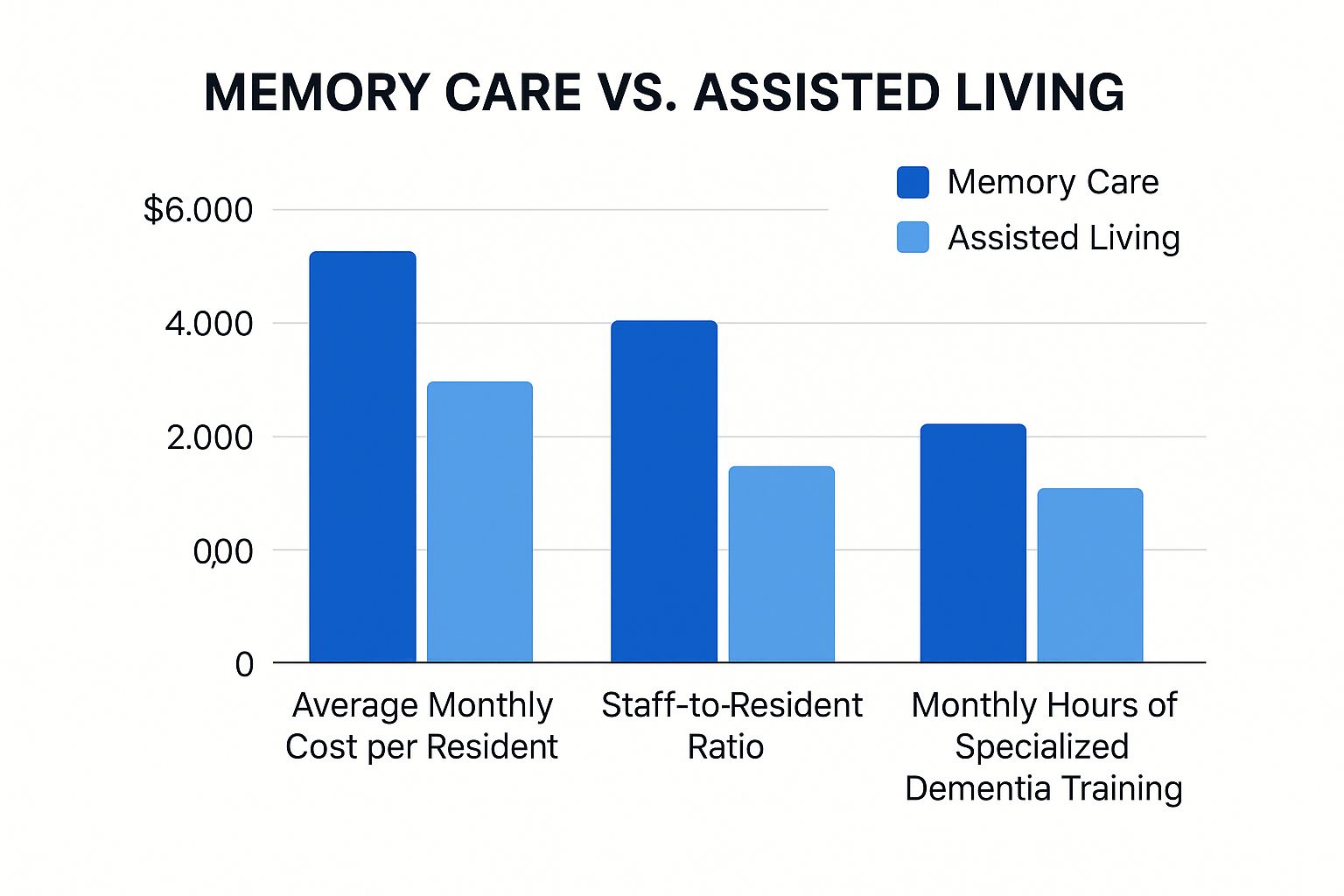When you start looking into senior care, the terms memory care vs assisted living can be confusing. It's easy to see why. The simplest way to think about it is that all memory care is a type of assisted living, but not all assisted living includes memory care. The key difference really comes down to specialization.
Assisted living is all about providing general support to help seniors maintain their independence. Memory care, on the other hand, is a secure, highly specialized environment built from the ground up for individuals navigating dementia.
Defining The Core Difference In Senior Care

To make the best choice for your family, it’s crucial to understand the fundamental purpose behind each option. Assisted living communities are designed for seniors who need a hand with Activities of Daily Living (ADLs)—things like preparing meals, remembering to take medication, or help with bathing—but are otherwise cognitively well. These communities feel much like an apartment complex with extra support services, prioritizing autonomy and social activities.
Memory care operates from a completely different philosophy. Think of it as a purpose-built sanctuary for those with Alzheimer’s or other forms of dementia. Here, safety, specialized programming, and a high degree of supervision are the cornerstones. The entire goal is to create a structured, secure setting that reduces the stress and confusion that often accompany memory loss.
A crucial differentiator lies in the staff's expertise. Memory care facilities require intensive, ongoing dementia-specific training for all staff, from caregivers to housekeepers. This ensures everyone understands how to manage behaviors like anxiety or wandering with compassion and skill.
This specialized training is a massive factor when weighing memory care vs assisted living. A caregiver in a standard assisted living facility provides essential daily support, but a memory care professional is specifically trained to navigate the complex cognitive and behavioral challenges of dementia. You can explore our visual resources on caregiving to learn more about caregiver qualifications.
To help you see the initial contrast more clearly, here's a quick side-by-side look at the two options.
High-Level Comparison Memory Care vs Assisted Living
This table gives a bird's-eye view of what sets these two care levels apart, focusing on their primary goals and the residents they are best suited to serve.
| Feature | Assisted Living | Memory Care |
|---|---|---|
| Primary Focus | Fostering independence with daily support | Providing safety and specialized dementia care |
| Resident Profile | Needs help with ADLs, cognitively sound | Alzheimer's or other dementia diagnoses |
| Environment | Residential, open, social | Secure, structured, calming |
| Staff Training | General care and assistance | Intensive, dementia-specific certification |
As you can see, the choice isn't just about the level of help needed, but the type of help. One focuses on physical support for an independent lifestyle, while the other provides comprehensive cognitive and environmental support for safety and well-being.
What Assisted Living Truly Provides

Assisted living offers a fantastic blend of independence and support. It's designed for seniors who don't need intensive, round-the-clock medical supervision but could use a reliable safety net. Think of it less like a healthcare facility and more like a vibrant residential community that offers a helping hand when needed.
The main focus is providing assistance with Activities of Daily Living (ADLs). These are the fundamental self-care tasks that can become more challenging with age—things like bathing, getting dressed, preparing meals, or managing medications. The whole point is to bridge the gap between living completely on your own and needing skilled nursing care.
A Focus On Autonomy And Social Life
Where memory care is designed for security, assisted living is built to foster freedom and social connection. Residents typically have their own private or semi-private apartments, which gives them a real sense of personal space and home.
The community atmosphere is one of the biggest draws. These communities are bustling hubs of activity, often including:
- Restaurant-style dining where residents can enjoy meals together.
- Housekeeping and laundry services, taking the burden of daily chores off their plate.
- Transportation for errands, doctor's appointments, and fun group outings.
- A rich calendar of social events, from fitness classes and book clubs to local excursions.
This setup helps seniors stay active and connected, which is absolutely vital for their overall well-being. To see how these roles fit into the broader spectrum of senior care, you can look at our visual guide to caregiving roles and their specific responsibilities.
Who Is The Ideal Candidate?
Picture a senior who is still sharp and loves their independence but is starting to find that cooking every single meal is exhausting. Maybe they struggle a bit with mobility or occasionally forget to take a pill, but they don't have significant cognitive decline or a tendency to wander.
Assisted living thrives on supporting this exact scenario. It provides just enough help to ensure safety and comfort without stripping away the resident's autonomy or lifestyle.
In the memory care vs assisted living discussion, the resident's cognitive health is the clearest dividing line. Assisted living is the perfect fit for seniors who need physical support but are still fully capable of managing their own day, making decisions, and enjoying a vibrant community life. It empowers them to live safely and comfortably while holding onto their treasured independence.
Inside a Specialized Memory Care Environment
A memory care community is so much more than just a place to live; it's a carefully crafted environment designed from the ground up to support people with cognitive decline. Every single detail, from the architecture to the daily operations, is intentional. The goal is to manage the specific challenges of dementia, like agitation, confusion, and the risk of wandering. This specialized approach is one of the biggest differences you'll find when comparing memory care vs assisted living.
Think about the layout. Unlike the open, apartment-style feel of many assisted living facilities, memory care is built for safety and to reduce stress. You'll often see secure perimeters and continuous, circular hallways. These smart designs prevent residents from hitting a frustrating dead end—which can easily trigger anxiety—and instead gently guide them along a safe, calming path.
Designed for Dignity and Safety
This specialized focus touches every part of the facility. The physical setting in memory care is tailored with safety features like door alarms, motion-sensing lights, and even adjusted fixtures to lower the risk of accidents or confusion. While assisted living homes are supportive, they typically don't include these critical features, which are essential for keeping someone with dementia safe. You can learn more about how these layouts impact dementia care on arborcompany.com.
Beyond the physical space, daily life is thoughtfully structured to offer a sense of predictability and purpose. For someone with memory loss, this is incredibly calming.
This structured support includes:
- Structured Routines: Having consistent times for meals, activities, and rest helps residents feel secure and grounded in their day.
- Therapeutic Activities: Programs here aren't just for fun; they're designed for cognitive engagement. This often means things like art therapy, music therapy, and sensory activities that can both soothe and stimulate residents.
- 24/7 Specialized Staff: Help is always there. Staff members have dementia-specific training, so they know how to respond to challenging situations with skill and genuine compassion.
At its heart, a memory care environment is about creating a world that adapts to the resident, not forcing the resident to adapt to the world. Every element works together to preserve dignity, enhance safety, and promote a high quality of life.
This complete approach ensures residents are not just safe, but also engaged in a way that feels meaningful. You can see some helpful visual resources on caregiving to get a better sense of how these specialized roles support residents. It's all about building a supportive ecosystem that helps manage symptoms and allows people to live with comfort and respect.
When you start comparing memory care vs. assisted living, the real differences pop up in the day-to-day experience of the residents. It’s one thing to read a brochure, but another to understand how life actually feels inside these communities. The services, the staff, and the daily rhythm are fundamentally different because they’re built for entirely different purposes.
Think of it this way: assisted living is designed to support a person's independence, while memory care is all about providing a safe, therapeutic environment for someone with cognitive decline.
Staff Expertise and Ratios
One of the biggest distinctions you'll find is in the staff's training. In an assisted living community, the team is fantastic at helping with physical tasks, what we call Activities of Daily Living (ADLs). They're there to help with medication reminders, offer a steady arm for mobility, and assist with personal care, all in a supportive role that respects a resident's autonomy.
Memory care, on the other hand, requires a whole different level of expertise. Staff in these communities get specialized, ongoing training specifically for dementia care. They are experts at managing the cognitive and behavioral symptoms that come with Alzheimer's and other forms of dementia—things like agitation, sundowning, or confusion. This specialized knowledge is absolutely crucial for providing compassionate, effective care that doesn't just manage but understands the resident's reality.
The staffing models also tell a story. Assisted living communities maintain a good staff-to-resident ratio, making sure someone is always available to meet both scheduled and unexpected needs for physical help.
But memory care needs a much higher staff-to-resident ratio. This isn't just a "nice to have"; it's essential for ensuring constant supervision and immediate assistance. With more staff on hand 24/7, caregivers can provide more one-on-one attention, gently redirect a resident who is feeling anxious, and create a truly secure setting for everyone.
The core difference isn't just about having more staff; it's about having the right staff. A caregiver trained in dementia can de-escalate a situation caused by confusion, whereas a general caregiver might not have the tools, turning a minor issue into a major one.
This is a key area where families see the value. That extra level of training can make all the difference in a loved one's quality of life.

As you can see, the higher investment in memory care directly funds more intensive training and a higher number of specialized staff, which is foundational to resident safety and well-being.
Environment and Daily Routines
The physical space and daily schedule also diverge quite a bit. Assisted living is built to encourage autonomy. You'll often find apartment-style living and a flexible social calendar packed with classes, outings, and events that residents can choose to join.
Memory care communities are different by design. They are physically secure to prevent wandering, which is a common and dangerous behavior for people with dementia. You'll often see circular layouts that avoid dead-end hallways, as these can cause frustration and anxiety. Life is also highly structured, because a predictable routine is incredibly calming for someone experiencing memory loss.
To help you visualize these differences, here’s a more detailed look at what a resident can expect in each setting.
Detailed Feature Breakdown: Assisted Living vs. Memory Care
This table breaks down the key operational and environmental features of each option.
| Comparison Point | Assisted Living | Memory Care |
|---|---|---|
| Physical Layout | Open, independent apartment-style living with communal areas. | Secured environment with alarms and circular layouts to prevent wandering and reduce agitation. |
| Daily Structure | Flexible social calendar with diverse activities and outings. Residents choose how to spend their day. | Predictable, structured routine for meals, activities, and rest to provide comfort and security. |
| Dining Experience | Restaurant-style communal dining, focusing on social interaction and choice. | Specialized dining support, often with finger foods, adapted utensils, and nutritional monitoring for cognitive and physical challenges. |
| Core Activities | Hobby groups, fitness classes, educational lectures, and community outings. | Therapeutic activities like music therapy, art therapy, and sensory stimulation designed to engage and soothe. |
Ultimately, choosing between memory care vs. assisted living comes down to what kind of support your loved one truly needs. One provides a safety net for a largely independent life, while the other creates a comprehensive, secure world tailored to the unique journey of memory loss.
Navigating the Costs of Senior Care
Talking about the financial side of senior care is a crucial step for families weighing their options. When you compare memory care vs. assisted living, you’ll notice a significant price difference. It’s important to understand that this isn't arbitrary—the higher cost of memory care is directly tied to the intensive level of specialized support, security, and staffing it provides.
So, why the higher price tag? It funds a completely different model of care. You're investing in continuous, specialized training for every staff member on dementia-specific needs, advanced security systems to prevent wandering, and a much higher staff-to-resident ratio. This ensures someone is always available for supervision and personalized attention. Essentially, you're paying for a secure, therapeutic environment run by experts.
Breaking Down the Monthly Fees
Both assisted living and memory care typically bundle services into a single monthly fee, but what's inside that bundle can vary. For assisted living, the fee usually covers rent, three meals a day, basic housekeeping, transportation, and a calendar full of social activities. If your loved one needs more personal help, like with bathing or managing medications, that might cost extra, often based on a tiered system that reflects their level of need.
Memory care fees, on the other hand, are almost always more inclusive because the specialized services are non-negotiable. The monthly rate generally covers everything you’d find in assisted living, plus:
- 24/7 supervision by staff specifically trained in dementia care.
- A secure, specially designed living environment to ensure safety.
- Therapeutic programming like art, music, or sensory activities designed to engage and calm residents.
- Personalized care plans that are constantly adapted as cognitive needs change.
The sheer cost of dementia care worldwide underscores how resource-heavy this kind of support is. Globally, direct healthcare spending related to dementia is enormous, which is a direct reflection of the specialized resources required. You can learn more about the economic impact of dementia care from recent studies.
Exploring Payment and Funding Options
Financing is a major piece of the puzzle, and the ways you can pay often differ between memory care and assisted living. While most families rely on private funds, there are other avenues to explore, though the eligibility rules can get complicated.
Long-Term Care Insurance: Most policies will cover both assisted living and memory care, but check the details. The daily benefit amount may be higher for memory care to account for the greater cost. It’s vital to review your specific policy to understand coverage limits and what officially triggers benefits for dementia-related care.
Medicaid Waivers: Many states have Home and Community-Based Services (HCBS) waivers that can help pay for care services in an assisted living community. However, not all of these waivers cover memory care. The ones that do often have very strict eligibility requirements and, unfortunately, long waiting lists.
Veterans (VA) Benefits: The Aid and Attendance benefit can be a huge help, providing a significant monthly pension to eligible veterans and their surviving spouses. This money can be used for both assisted living and memory care. This benefit is need-based and requires a doctor's confirmation that the applicant requires daily assistance with their personal care.
How to Make the Right Choice for Your Family

Choosing between memory care and assisted living isn't about ticking boxes on a checklist. It's a deeply personal process, and the right path forward depends entirely on your loved one’s unique cognitive health, safety needs, and daily life. This decision really calls for a careful and honest look at their current situation.
Start by thinking about the progression of their condition. Someone in the very early stages of dementia who still manages most of their day might do wonderfully in the social setting of assisted living. But if their cognitive decline is advancing, the structured support of memory care becomes a much better fit.
Evaluating Key Decision Points
The conversation about memory care vs assisted living usually comes down to a few critical factors. To get some clarity on the best choice, ask yourself these essential questions about your loved one's day-to-day life:
- Safety and Wandering: Is there any risk they might leave home and get lost? Wandering is a serious safety risk that immediately points toward the secure environment of a memory care community.
- Daily Function: Are they having trouble with basic self-care, getting proper nutrition, or taking medications to a point where it's affecting their health? While assisted living can help, memory care provides more intensive, hands-on support specifically for cognitive challenges.
- Social Engagement: Do they seem agitated or withdrawn in social situations? Assisted living has a flexible social calendar, but the therapeutic, small-group activities in memory care are designed to lower anxiety and offer gentle engagement.
The need for these specialized services is growing. Back in 2020, about 50 million people worldwide were living with dementia. This number shows just how much demand there is for facilities equipped to manage cognitive impairment. You can find more details on global dementia trends on ultimatecareny.com.
While your family’s observations are priceless, a professional medical assessment is the most important step. A geriatrician or neurologist can give a clear diagnosis and a clinical recommendation on the right level of care. This will give your family confidence as you make your final choice.
Ultimately, the best decision is the one that strikes the right balance of safety, dignity, and quality of life. An assisted living community can be a fantastic option for someone who needs a hand with physical tasks, but when cognitive safety becomes the main concern, a dedicated memory care unit is essential.
Common Questions About Senior Living Options
Making the choice between memory care and assisted living naturally brings up some tough, but important, questions. Getting clear answers can bring your family much-needed peace of mind during a challenging transition.
Can Someone With Early-Stage Dementia Live in Assisted Living?
Absolutely. A person in the earlier stages of dementia can often do very well in an assisted living community, particularly one that offers some light memory support. The decision really comes down to their safety and how well they can manage their day-to-day life.
If they aren’t at risk of wandering and can still participate in social activities with a bit of encouragement, assisted living can be a great fit. It’s crucial, however, to think about the long term. As dementia progresses, their needs will change, and a move to a specialized memory care unit will likely become necessary to ensure they get the right level of support.
What's the Main Sign a Move to Memory Care Is Needed?
In one word: safety. When a person's cognitive decline starts creating a real risk to themselves or others, it’s time to seriously consider memory care.
This isn't just about forgetfulness. It’s about specific, concerning behaviors, such as:
- Wandering away from home or getting lost in familiar places
- Forgetting to turn off kitchen appliances, like the stove
- Showing noticeable agitation, confusion, or aggression
- Struggling to manage basic personal care, like hygiene or getting enough to eat
When safety becomes the primary worry, the secure environment and specially trained staff of a memory care community are no longer just helpful—they’re essential.
The day-to-day experience is also fundamentally different. Assisted living focuses on social engagement with activities like fitness classes and group trips. In memory care, activities are more therapeutic—things like music therapy or sensory engagement are designed to provide a gentle sense of purpose and calm anxiety.
Choosing the right care setting is one of the most important decisions a family can make. For those in Princeton, NJ, and the greater Mercer County area who are looking for compassionate, professional support at home, NJ Caregiving provides a personalized alternative. Find out more about our skilled nursing and personal care services.



